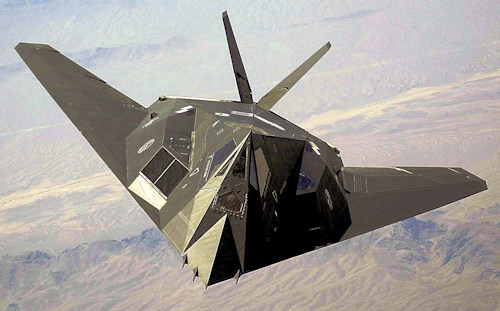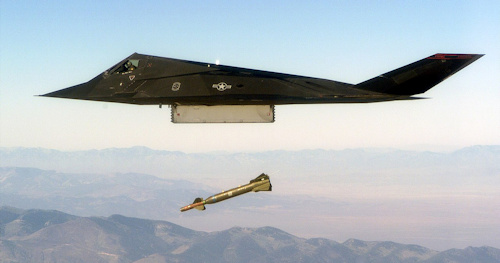The specifications that led to the birth of the F-117 were branched towards the end of the 70 years, even if the first studies and the first evaluations about the design of an aircraft Invisible the radars date back to the end of the Second World War. However, only with the advent of information technology has it been possible to give substance to the studies.
The qualities stealth of the F-117 and its low value of RCS (Radar Cross Section), contrary to what is generally believed, depend only minimally on the use of composite materials, used more than anything else to lighten the maximum weight of the aircraft . The low visibility of the F-117 to the radar is mainly due to the use of radar-absorbing materials (RAM), the almost total renunciation of curvilinear surfaces or segments - according to a technique called faceting ("facet") - as well as the elimination of high-radar-reflecting points.
The cell of the Nighthawk it is in aluminum alloy, above which RAM panels are applied; externally, the surface takes on the appearance of a series of tiles glued to a metal frame, all covered with a rough-textured paint, which incorporates microscopic spheres of ferrous material.
 The shape edgy the aircraft has been specially designed to disperse the incident radar radiation in all directions. It was the complex application of a rather simple idea: if the purpose of a radar station is to emit electromagnetic waves that return to the receiver after hitting the target, then the secret to not being discovered is simply to not allow to the waves themselves to return to the source.
The shape edgy the aircraft has been specially designed to disperse the incident radar radiation in all directions. It was the complex application of a rather simple idea: if the purpose of a radar station is to emit electromagnetic waves that return to the receiver after hitting the target, then the secret to not being discovered is simply to not allow to the waves themselves to return to the source.
Thanks to the faceted profile, the wedge shape with an 67,5 ° angle and details indentations present on the cockpit and on the cargo compartment doors and carriages, the radar emissions affecting the F-117 are reflected in all directions and will not return except in a small percentage to the starting direction so that on the screen of the " there is no trace of the presence of the aircraft. Always to reduce the RCS also the war load is housed in two inner racks, which are only opened during the release phase.
The third point behind the technology stealth is the elimination of critical points such as antennas, air intakes, cockpit transparencies, projections of all kinds, joints and fuselage-wing connectors and fuselage-tail planes, which generally act as reflectors for incident radiation and are consequently the main leaders of the RCS. Some of these indispensable structures have been reconfigured on the F-117 as retractable appendages (such as the two ILS antennas located just behind the passenger compartment) or as cavities, in the case of the two air intakes.
 The same engine exhaust has been designed to disperse the hot air flow over a surface that is more than twice the normal cone of the reactors; In addition, the flow is mixed with external air to lower its output temperature and is slightly offset, which makes it even harder to detect from a ground station.
The same engine exhaust has been designed to disperse the hot air flow over a surface that is more than twice the normal cone of the reactors; In addition, the flow is mixed with external air to lower its output temperature and is slightly offset, which makes it even harder to detect from a ground station.
The two V-tail planes, fully mobile on their axles, have been positioned so as to mask the heat from above, and make the F-117 less identifiable by a radar aircraft. The FLIR apparatus, also featuring a target laser guided targeting target (LGB), is inserted into the cavity immediately in front of the passenger compartment, which is also screened from a grid.
Il Nighthawk it has been expressly conceived to carry out ground attack missions, that is, to target delimited but strategically important and consequently highly protected objectives. In fact, a typical mission of the F-117 is to decapitate the enemy structures that go under the name of C4I (Command, Control, Communications, Computer and Intelligence). For these tasks the aircraft can use two GBU-27 guided laser guided bombs (BLUE 109 / B) from 2.000 pounds. Absent any other armament, including that for self-defense that remains in the capacity stealth plane.
 The first mission of real use of the F-117 was the operation Just Cause for the invasion of Panama in December of the 1989, to which six aircraft took part. Two of them were commissioned to release bombs in support of landing operations by the USS Ranger, their mission turned out to be a complete failure. Two other F-117s were tasked with providing support for a detachment of Special Forces whose job was to capture General Noriega, but he could not identify his proper location. The last two were stock planes coming directly from the United States after a long voyage surfaced by numerous flying supplies.
The first mission of real use of the F-117 was the operation Just Cause for the invasion of Panama in December of the 1989, to which six aircraft took part. Two of them were commissioned to release bombs in support of landing operations by the USS Ranger, their mission turned out to be a complete failure. Two other F-117s were tasked with providing support for a detachment of Special Forces whose job was to capture General Noriega, but he could not identify his proper location. The last two were stock planes coming directly from the United States after a long voyage surfaced by numerous flying supplies.
It was the task of the latter to disorient Rio Hato's staff members by intimidating them with the launch of GBU-27 bombs in the immediate vicinity of the infrastructure. In US military environments, the mission was considered a success, since the F-117 had proven to be able to hit any target accurately without anyone intercepting them or even just identifying their presence.
During the very first steps of the operation Desert Storm, an F-117 struck Baghdad's telecommunications building, for military-purpose use by Saddam Hussein's Supreme Command. In total, during the Gulf War, no less than 40 F-117 was deployed to Khamis Mushait, Saudi Arabia; their intervention is credited about the 30% of the targets hit on the first day, whose timely destruction favored the rapid end of the war. During 42 days of operation, the F-117 performed 1.271 missions, flying an average of 5 hours and a half per mission, releasing no less than 2.000 tons of explosive ordnance with a precision rate close to the 85% and without suffering losses.
However his invulnerability suffered a severe blow during the Kosovo conflict. In fact, the 27 March 1999 the Serbian Commands announced the demolition of an F-117, attaching numerous photos and wreck videos. Probably the plane was dropped during the armed release phase, ie when the doors were opened, by a Russian SA-3 missile driven by a radar operating at unusually long frequencies. It is likely that with that slaughter the decline of the Nighthawk, also seen the debut in that conflict of strategic bomber B-2 Spirit, able to carry a warship ten times higher than the F-117 and with the ability to operate directly from the United States with only one in-flight supply.

(photo: US Air Force / web)












